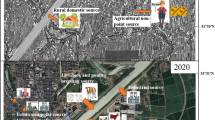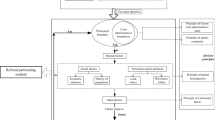Abstract
This study presents an integrated approach for targeting critical source areas (CSAs) to control nonpoint source pollution in watersheds. CSAs are the intersections between hydrologically sensitive areas (HSAs) and high pollution producing areas of watersheds. HSAs are the areas with high hydrological sensitivity and potential for generating runoff. They were based on a soil topographic index in consistence of a saturation excess runoff process. High pollution producing areas are the areas that have a high potential for generating pollutants. Such areas were based on simulated pollution loads to streams by the Soil and Water Assessment Tool. The integrated approach is applied to the Neshanic River watershed, a suburban watershed with mixed land uses in New Jersey in the U.S. Results show that several land uses result in water pollution: agricultural land causes sediment, nitrogen and phosphorus pollution; wetlands cause sediment and phosphorus pollution; and urban lands cause nitrogen and phosphorus pollution. The primary CSAs are agricultural lands for all three pollutants, urban lands for nitrogen and phosphorus, and wetlands for sediment and phosphorus. Some pollution producing areas were not classified into CSAs because they are not located in HSAs and the pollutants generated in those areas are less likely to be transported by runoff into streams. The integrated approach identifies CSAs at a very fine scale, which is useful for targeting the implementation of best management practices for water quality improvement, and can be applied broadly in different watersheds to improve the economic efficiency of controlling nonpoint source pollution.





Similar content being viewed by others
References
Ardon M, Montanari S, Morse JL, Doyle MW, Bernhardt ES (2010) Phosphorus export from a restored wetland ecosystem in response to natural and experimental hydrologic fluctuations. J Geophys Res 115(G4):1–12
Arnold JG, Srinivasan R, Muttiah RS, Williams JR (1998) Large area hydrologic model development and assessment part 1: model development. J Am Water Resour As 34(1):73–89
Brenning A (2007) RSAGA: SAGA geoprocessing and terrain analysis in R, available at: http://cran.r-project.org/web/packages/RSAGA/index.html. Accessed 24 July 2016.
Buchanan BP, Archibald JA, Easton ZM, Shaw SB, Schneider RL, Walter MT (2013) A phosphorus index that combines critical source areas and transport pathways using a travel time approach. J Hydrol 486:123–135
Buchanan BP, Fleming M, Schneider RL, Richards BK, Archibald J, Qiu Z, Walter MT (2014) Evaluating topographic wetness indices across central New York agricultural landscapes. Hydrol Earth Syst Sc 18(8):3279–3299
Carpenter SR, Caraco NF, Correll DL, Howarth RW, Sharpley AN, Smith VH (1998) Nonpoint pollution of surface waters with phosphorus and nitrogen. Ecol Appl 8(3):559–568
Chen L, Qian X, Shi Y (2011) Critical area identification of potential soil loss in a typical watershed of the three gorges reservoir region. Water Resour Manag 25:3445–3463
Costa-Cabral MC, Burges SJ (1996) Digital elevation model networks (DEMON): a model of flow over hillslopes for computation of contributing and dispersal areas. Water Resour Res 30(6):1681–1692
Diebel MW, Maxted JT, Nowak PJ, Zanden MJV (2008) Land scape planning for agricultural nonpoint source pollution reduction I: a geographic allocation framework. Environ Manag 42(5):789–802
Doody DG, Archbold M, Foy RH, Flynn R (2012) Approaches to the implementation of the water framework directives: targeting mitigation measures at critical source areas of diffuse phosphorus in Irish catchments. J Environ Manag 93(1):225–234
Ghebremichael LT, Veith TL, Hamlett JM (2013) Integrated watershed and farm scale modeling framework for targeting critical source areas while maintaining farm economic viability. J Environ Manag 114:381–394
Giri S, Nejadhashemi AP, Woznicki SA (2012) Evaluation of targeting methods for implementation of best management practices in the Saginaw River watershed. J Environ Manag 103:24–40
Gupta HV, Sorooshian S, Yapo PO (1999) Status of automatic calibration for hydrologic models: Comparison with multilevel expert calibration. J Hydrol Eng 4(2):135–143
Gyawali S, Techato K, Yuangyai C, Musikavong C (2013) Assessment of relationship between landuses of riparian zone and water quality of river for sustainable development of river basin, a case study of U-Tapao river basin, Thailand. Prog Environ Sci 17:291–297
Hayakawa A, Shimizu M, Woli KP, Kuramochi K, Hatano R (2006) Evaluating stream water quality through landuse analysis in two grassland catchments: impact of wetlands on stream nitrogen concentration. J water Qual Manage 35(2):617–627
Herron NF, Hairsine PB (1998) A scheme for evaluating the effectiveness of riparian zones in reducing overland flow to streams. Aust J Soil Res 36(4):683–698
Hong B, Swaney D (2007) Generating maps of soil topographic index. Cornell University, Soil and Water Research Group Accessed 24 July 2016Available at: http://soilandwater.bee.cornell.edu/tools/STI.pdf
Horn BK (1981) Hill shading and the reflectance map. P IEEE 69:14–47
Kaini P, Artita K, Nicklow JW (2012) Optimizing structural best management practices using SWAT and genetic algorithm to improve water quality goals. Water Resour Manag 26(7):1827–1845
Kumar S, Mishra A (2015) Critical erosion area identification based on hydrological response unit level for effective sediment control in a river basin. Water Resour Manag 29(6):1749–1765
Lyon SW, Ge′rard-Marcant P, Walter MT, Steenhuis TS (2004) Using a topographic index to distribute variable source area runoff predicted with the SCS-curve number equation. Hydrol Process 18(15):2757–2771
Machiwal D, Madan KJ, Mal BC (2006) Modelling infiltration and quantifying spatial soil variability in a watershed of Kharagpur, India. Biosyst Eng 95(4):569–582
Miller JD, Schoonover JE, Williard KWJ, Hwang CR (2011) Whole catchment land cover effects on water quality in the lower Kaskaskia River watershed. Water Air Soil Pollut 221:337–350
Moriasi DN, Arnold JG, Van Liew MW, Binger RL, Harmel RD, Veith V (2007) Model evaluation guidelines for systematic quantification of accuracy in watershed simulations. Trans ASABE 50(3):885–900
Nash JE, Sutcliffe JV (1970) River flow forecasting through conceptual models: part 1. A discussion of principles. J Hydrol 10(3):282–290
NASS (2014) National Agricultural Statistics Service: CropScape-Cropland Data Layer Available at: http://nassgeodata.gmu.edu/CropScape/. Accessed 24 July 2016.
NJDEP (2011) Surface water quality standards. NJAC 7:9B, Bureau of Water Quality Standards and Assessment, NJDEP, Trenton, NJ.
Pandey A, Chowdary VM, Mal BC (2007) Identification of critical erosion prone areas in the small agricultural watershed using USLE, GIS and remote sensing. Water Resour Manag 21(4):729–746
Pratt B, Chang H (2012) Effects of land cover, topography, and built structure on seasonal water quality at multiple spatial scales. J Hazard Mater 209:48–58
Qiu Z (2009) Assessing critical source areas in watersheds for conservation buffer planning and riparian restoration. Environ Manag 44(5):968–980
Qiu Z, Wang L (2014) Hydrological and water quality assessment in a suburban watershed with mixed land uses using the SWAT model. J Hydrol Eng 19(4):816–827
Seibert J, McGlynn BL (2007) A new triangular multiple flow direction algorithm for computing upslope areas from gridded digital elevation models. Water Resour Res 43(4):W04501
Shen Z, Hong Q, Chu Z, Gong Y (2011) A framework for priority non-point source area identification and load estimation integrated with APPI and PLOAD model in Fujiang watershed, China. Agr water Manage 98(6):977–989
Shen Z, Zhong Y, Huang Q, Chen L (2015) Identifying non-point source priority management areas in watersheds with multiple functional zones. Water Res 68:563–571
Singh, J, Knapp HV, Demissie M (2004) Hydrologic modeling of the Iroquois River watershed using HSPF and SWAT. ISWS CR 2004–08. Champaign, Ill.: Illinois State Water Survey. http://swat.tamu.edu/media/90101/singh.pdf. Accessed 24 July 2016.
Sivertun A, Prange L (2003) Non-point source critical area analysis in the Gisselo watershed using GIS. Environ Model Softw 18(10):887–898
Srinivasan MS, McDowell RW (2009) Identifying critical source areas for water quality: 1. Mapping and validating transport areas in three head water catchments in Otago New Zealand. J Hydrol 379(1):54–67
Thompson JJD, Doody DG, Flynn R, Watson CJ (2012) Dynamics of critical source areas: does connectivity explain chemistry? Sci Total Environ 435:499–508
Trevisan D, Dorioz JM, Poulenard J, Quetin P, Combaret CP, Merot P (2010) Mapping of critical source areas for diffuse fecal bacterial pollution in extensively grazed watersheds. Water Res 44(13):3847–3860
Tuppad P, Srinivasan R (2008) Bosque River environmental infrastructure improvement plan: phase II BMP modeling report. Publ. No. TR-313College Station, TX: Texas A&M Univ., Texas AgriLife Research.
USEPA (2009) National water quality inventory: Quality of our nation’s water: report to congress 2004 reporting cycle. EPA 841-R-08-001. US Environmental Protection Agency, Office of Water, Washington DC.
Walter MT, Walter MF, Brooks ES, Steenhuis TS, Boll J, Weiler K (2000) Hydrologically sensitive areas: Variable source area hydrologically implications for water quality risk assessment. J Soil Water Conserv 55(3):277–284
Wan R, Cai S, Li H, Yang G, Li Z, Nie X (2014) Inferring landuse and land cover impact on stream water quality using a Bayesian hierarchical modeling approach in the Xitiaoxi river watershed China. J Environ Manag 133:1–11
Wang L, Liu H (2006) An efficient method for identifying and filling surface depressions in digital elevation models for hydrologic analysis and modelling. Int J Geogr Inf Sci 20(2):193–213
White MJ, Storm DE, Busteed PR, Stoodley SH, Phillips SJ (2009) Evaluating nonpoint source critical source area contributions at the watershed scale. J Environ Qual 38(4):1654–1663
Wilson C, Weng Q (2010) Assessing surface water quality and relation with urban land cover changes in the Lake Caumet area, greater Chicago. Environ Manag 45(5):1096–1111
Zampella RA, Procopio NA, Lathrop RG, Dow CL (2007) Relationship of landuse/land-cover patterns and surface water quality in the Mullica River basin. J Am Water Resour Assoc 43(3):594–604
Zhou H, Gao C (2011) Assessing the risk of phosphorus loss and identifying critical source areas in the Chaohu Lake watershed, China. Environ Manag 48(5):1033–1043
Acknowledgments
The authors acknowledge the funding support by the USDA National Institute of Food and Agriculture through an Agriculture and Food Research Initiative Competitive Grant to New Jersey Institute of Technology (Grant Number 2012-67019-19348).
Author information
Authors and Affiliations
Corresponding author
Ethics declarations
The project is partially supported by the U.S. Department of Agriculture National Institute of Food and Agriculture (Award #: 2012–67019-19348) to New Jersey Institute of Technology. The manuscript is an original contribution of all listed authors. There are no potential conflicts of interests or human/animal subject involvement. Proper acknowledgements to others have been made through the references.
Rights and permissions
About this article
Cite this article
Giri, S., Qiu, Z., Prato, T. et al. An Integrated Approach for Targeting Critical Source Areas to Control Nonpoint Source Pollution in Watersheds. Water Resour Manage 30, 5087–5100 (2016). https://doi.org/10.1007/s11269-016-1470-z
Received:
Accepted:
Published:
Issue Date:
DOI: https://doi.org/10.1007/s11269-016-1470-z




